Here is my method for relaxing Lepidoptera. Just like everything else, it seems like everyone has their own system and procedure. Mine might not be best for every situation, but it is designed for pinned specimens in bulk. I get through a few thousand leps a year, but it can be easily scaled to meet your needs.
- I use one of these medium-large snap-top Tupperware containers that you can find in any market. The dimensions are roughly 8″x5.5″x7″. Any well-sealing container can be used.
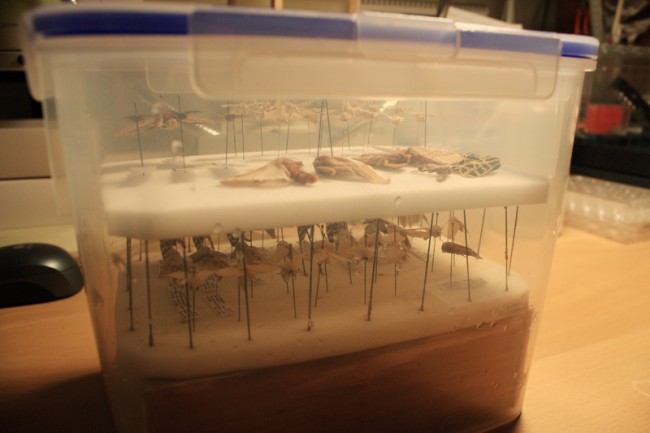 I create a support frame by cutting the bottom off of and then out of a smaller Tupperware container – essentially a rectangular plastic support (the frame in the image is wood, which was my old method). This keeps the bottom pinning surface out of the water, which means it’s very easy to lift out. Placing the foam directly onto water causes a slight adhesion that makes removal difficult, especially without dripping or splashing. Within the frame I stuff paper towels for absorbance.
I create a support frame by cutting the bottom off of and then out of a smaller Tupperware container – essentially a rectangular plastic support (the frame in the image is wood, which was my old method). This keeps the bottom pinning surface out of the water, which means it’s very easy to lift out. Placing the foam directly onto water causes a slight adhesion that makes removal difficult, especially without dripping or splashing. Within the frame I stuff paper towels for absorbance.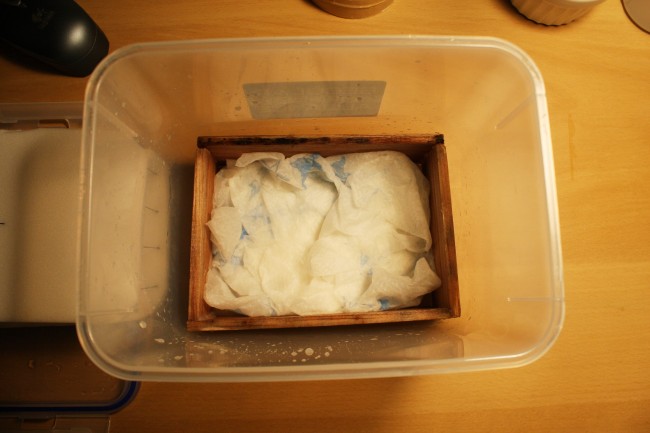 Add enough tap water to moisten the towels but be careful not to allow for standing water. This is just a precaution to avoid splashing, especially if the container is bumped or knocked over. Recently I’ve been using deionized water, which seems to work faster than tap water; and I avoid using hot water because the excess steam creates too much condensation that can drip onto the specimens. My theory is the slower the better, no reason to rush good specimens! But if I am ever in a rush I will add warm water or gently heat the relaxer making sure to leave the top layer empty as a drip-guard. When using hot water be sure to insulate the top of your container to help resist condensation. De, heat can create excess greasing in some species, so this should be avoided unless absolutely necessary!
Add enough tap water to moisten the towels but be careful not to allow for standing water. This is just a precaution to avoid splashing, especially if the container is bumped or knocked over. Recently I’ve been using deionized water, which seems to work faster than tap water; and I avoid using hot water because the excess steam creates too much condensation that can drip onto the specimens. My theory is the slower the better, no reason to rush good specimens! But if I am ever in a rush I will add warm water or gently heat the relaxer making sure to leave the top layer empty as a drip-guard. When using hot water be sure to insulate the top of your container to help resist condensation. De, heat can create excess greasing in some species, so this should be avoided unless absolutely necessary!- I cut foam pinning trays to fit. Using #7 pins (stainless would be best) I create a perimeter on top of which multiple layers of trays can be placed within one container; the middle two pins are placed as a pull. The bottom layer can not accommodate large specimens with wings folded dorsally, but they can either fit in the top layer or when only one layer is being utilized.
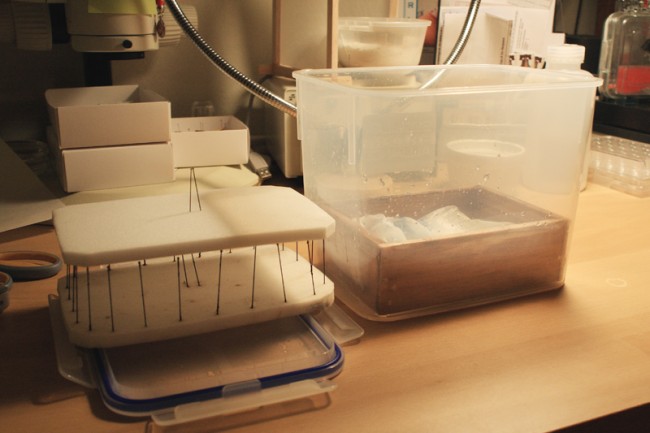
- I then load specimens and place into the relaxer. For papered specimens I simply place them flat onto the foam, but it is inefficient space-wise. It usually takes 6-8 hours for microleps to be relaxed, 1 day for small or delicate leps like slender Noctuids or Geometridae and 2-3 days for the majority of Noctuidae and even Saturniidae. Sphingidae seem to usually take 4-5 napok, and stubborn ones I inject with a small amount of water to facilitate relaxing. I can typically spread the contents of one relaxer in 4-5 óra (sometimes spread over 2 nights) and since I only have 20 spreading boards I never have had the need for constructing a second relaxing chamber.
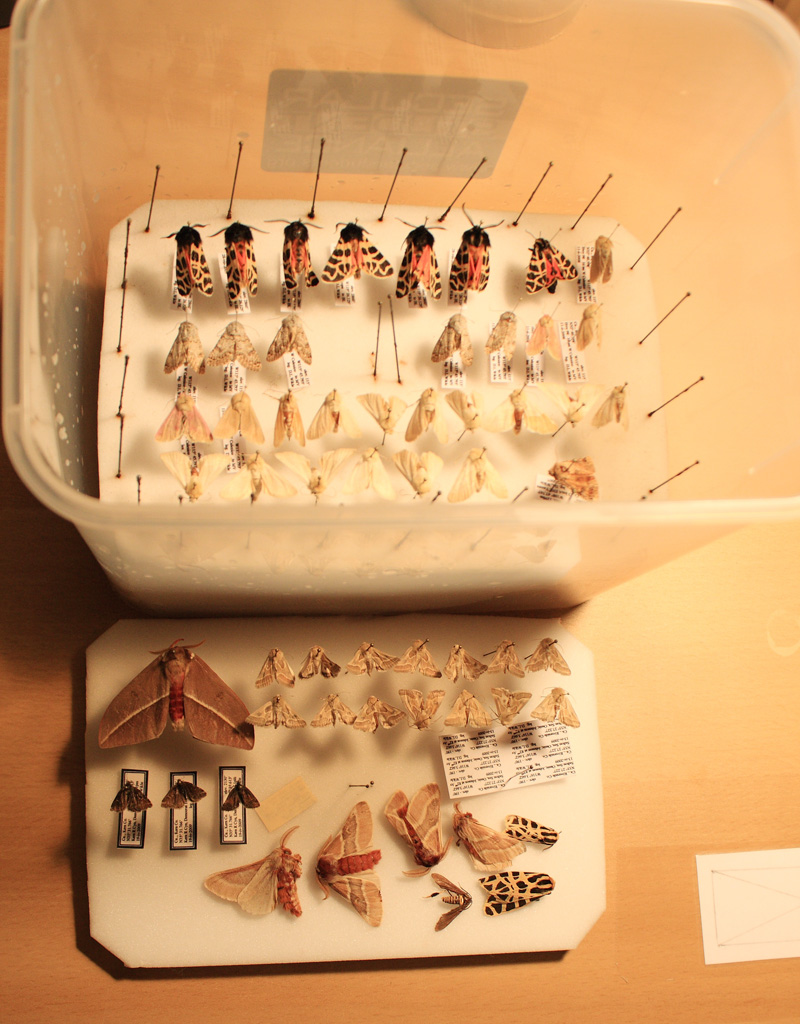
- I do NOT add any chemical mold repellant such as chlorocresol, naphthalene or PDB. I used PDB for a few years but the vapors are extreme, especially when working at your desk for hours. Instead I carefully wash all surfaces with 95% Ethanol for sterilization after each use (boiling water might be substituted). I allow for only a minute ethanol residue because excess alcohol inhibits proper relaxing and you end up with crispy wing-joints, even after a week. While this method prevents mold for 5-6 days it is not fool-proof. I have forgotten about specimens and within 7-8 days some light mold will begin. Despite this, I find this method creates the most satisfactorily relaxed specimens out of anything I’ve tried.
Az eredmények!
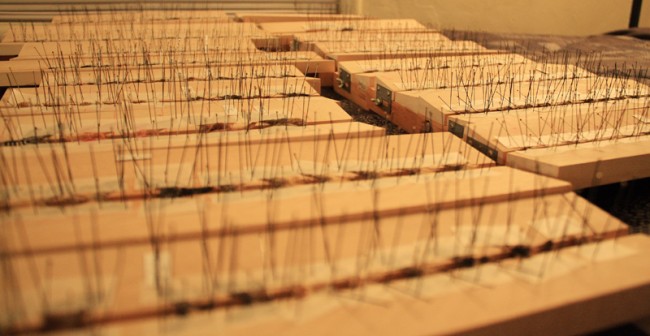

dude.
Im definitely going to have to try this, the only method I ever learned for leps was dipping the thorax in boiling water. I never liked the idea and always had mixed results. Have you tried relaxing other insect groups this way?
Btw, I like the set up and concept of you website and enjoying learning about what Lep freaks do 🙂
Yes this would work just fine for any group of insects, I’ve relaxed Hymenoptera this way with great results. Some of those really large beetles though take an extra effort, and I’m no help there!
I can imagine the dipping method is rough, I try to avoid any contact with water.
Here is an alternative relaxing method which you could use for quick relaxing: It gets the job done quickly but also gets things pretty damp.
http://www.insectnet.com/videos/instruct/billrelax/billrelax.htm
Köszönet!
Szia,
Have you relaxed mikro lepidoptera ???
I meen the small one.
And how can you control at butterfly do not get wet ??
Regard
Leif
For very tiny moths I do not relax – things like Nepticulidae have to be spread while partially alive or very, very freshly killed. Most tiny species need to be mounted this way if at all. When I find them in a light trap I just pin them without spreading. But when they are on a sheet I capture in small vials for prep under a microscope the next day.
Keeping the water at room temperature keeps the condensation minimal. I never have had drops forming on specimens.
what do i do if i relaxed a bug like 3 times like 3 days each and it is still not flexible. it is a stag beetle and the legs move, not the mandibles
Beetles are a special case and often require a totally different method for relaxing. Quickly submerging a specimen in warm or simmering water can do the trick – gentile relaxing at room temperature is really only for delicate specimens like Lepidoptera. You might want to search around on beetle blogger sites for better advice on relaxing big, stiff, beetles. Sok szerencsét!
“Csak” 20 spreading boards?! I am so envious of you and your mothing skills. I constructed my spreading board myself due to budgeting and it’s a bit… wanting.
Akárhogyan is, my question is this. I capture most of my specimens around 9 or 10pm, and directly move them into my kill jar. I leave the jar overnight and spread them in the morning around 8am. I’ve noted some difficulty in spreading the antennae and wings; the antennae tend to curl and the wings are always pressed tightly against the body, making it difficult to extract them without damage and sort of spring-loaded, wanting to return to the body as soon as I let go of the forceps. I am not an experienced spreader/pinner, as I only recently stopped releasing specimens, and I was wondering if you had any tips for me. Am I leaving them in the kill jar too long? Not long enough? Do I need to relax them after just one night after capture?
Thanks so much, your blog is fabulous and inspirational to an aspiring entomologist whose friends don’t really “get it”… I’m a senior in high school and am lacking resources for lepidoptergeekery! Please keep writing.
Olivia
Thanks for your comment Olivia! What type of killing jar are you using? You might be leaving them too long, if I leave them over night I tend to relax them for a few hours before spreading just to help loosen things up. If you’re collecting at home you should also consider using your freezer. If you knock things down in a killing jar you can transfer them to a tupperware with some tissue paper and pop them in the freezer. When you remove it be sure to allow it to come to room temperature for at least an hour or so before you start spreading again, everything should be perfectly fresh.
I’d just cobbled together a temporary kill jar with a canning jar and nail-polish remover-soaked cotton ball. I’ll use the freezer from now on, bár, thanks so much!
I moisten a towel paper in a petri dish with household vinegar to relax coleoptera. Leave them for 24h or longer if needed. This works fine for me. No problems with mold either if you leave them longer.
hello, i am debasish working on red banded mango caterpillar and i want to make the adult spread for preservation, can somebody help me to achieve that goal.
Am new to microlepidoptera………..but having a blast exploring the fauna of my area. The problem!……..pinning. I have collected coleoptera for over 40 years and that’s a pice of cake compared to micro-leps.
The specimens whose wings are basically flat when captured sem to be no problem regardless of size, but the moths which have sort of a triangular, pyramidal shape are the tough ones for me…….I succeed with about 1 -ben 10 !!! can’t seem to get the wings moved forward regardless of how carefully I use the pins without tearing or them breaking completely off.
The other problem are the ones where I move the forewing forward and then it flips up creating a long tear in the wing.
Help!!!!
Mike Poellot Saratoga, Kalifornia
Oops sorry for the late reply! Yes when a moth dies with the wings vertical it’s very hard to prepare the specimen. I pin the moth between my fingers as if it’s a large butterfly – then I use two forceps to manipulate the specimen upside down. One pair holding it over the foam and the other pair opening the wings as I pin it down. From there you can then gently pull the wings forward for spreading (if that makes sense?) It takes lots of practice with those!
Szia
does anybody like to share some tipps about how you’re relaxing large saturniidae like for example an Argema mittrei or Actias luna?
How to prevent the hairy body to catch too much humidity and still to get the muscles very tender relaxed. And the wings not getting soaked in humidity?
Maybe placing the specimen vertically in the relaxing box or conventional laying on a cotton surface?
Would appreciate a lot if somebody could describe here how you’re handling the process. I had an incident with an Actias luna which turned to be destroyed – water was sticking together the hairs on the body….
Any help and tipps are very appreciated.
Sounds like you’re leaving them in too long or using hot water? With room temp water even a big moth won’t become perfectly relaxed, but you can try injecting some warm water directly into the body to speed things along. Small syringes are cheap and easily purchased online. You can inject a little hot water into the moth and then relax it for 24 óra, which should suffice.
Okay – nagy, thank you a lot. Used that technique for a papilio antimachus. Worked quite well. Indeed I’m normally using hot water in my relaxing-box.
As you say i should maybe try with room temperature water.
Helló,
I have been mounting butterflies and moths for a few years but am still trying to perfect relaxing. If I use water, the specimens mould in 3 days and before some are relaxed. I read posts of a whole group of guys using vodka as a relaxing fluid. I have been using it for the last month with mixed results. I don’t get mould anymore but many of the saturniids get saturated bodies which mats the hairs. Maybe the problem has to do with the apparent need to inject fluid (vodka) into the bodies. Egyébként, heavy bodied specimens won’t relax sufficiently, even after 4 napok. I bought a can of P-Choro-m-Cresol from Bioquip to add water but I don’t have any idea how much of the crystals to add to how much water. Bármilyen ötletet? It doesn’t seem that any of you are using this method, but I am open to any and all suggestions.
Randy
I think one of the necessary things to do when using only water is to sterilize your container as much as possible – that can help with mold issues. But for large bodied moths and beetles you can inject a little warm water into their thorax before relaxing (you could cut it with alcohol, but I never found it necessary as long as you make sure you dry the specimens after). This will help a lot in cutting down the time required and will really help penetrate the dense muscles. The chlorocresol can work but it’s nasty stuff, leaving a strong odor and potentially has dangerous human side effects. The residue on the specimens can also cause them to relax easily in the future with even a little bit of humidity, causing specimens to droop.
Chris,
Thanks for the advice.
In sterilizing the relaxing containers, would washing in a dishwasher be sufficient or do you recommend something more rigorous? I am using rubbermaid food storage containers.
Is, I am about to try using Lysol. Any ideas about that?
Randy
A dishwasher would be perfect – but I’m not that strict about it. I just wash with 95% ethanol or I use boiling water. That usually takes care of things well enough.
Chris,
I’m finally getting around to standardizing the mounting height of the butterflies in my collection. It will be a fair task now that I have accumulated about 300 of them. I have a pinning block that I bought from Bioquip but I see a problem with it’s use. It standardizes the position of the bottom of the specimens rather than the tops. Since I have everything from tiny blues to the largest Saturnids, this poses a problem. It seems that I should be wanting to standardize the position of the top of the wings, or at least the tops of the thoraxes rather than the bottom of the thoraxes. What spacing should I use between the bead on the tops of the pins to the tops of the thoraxes?
Randy
I standardize the height by pinching the top of the pin and moving the specimen up to that height. It’s enough that my fingers don’t touch the specimen, and I just eyeball it – turns out to be about ~.4″/10mm. Half an inch is a bit much, and you don’t want the specimen being too close to the top such that fingers would contact the specimen. Some pinning blocks (the Rose Entomology design aluminum ones) have a larger hole that fits a pin head, which is exactly 10mm for distancing specimens down from the top.
I’ve a number of problems setting moths.
Particularly noctuids e.g. darts (and I have the same problems with skippers too).
These insects are strong fliers, that hold their wings in a low v shaped tent folded into the body.
Even if these are fresh, moving the forewing into position often causes the joint at the body to fold in on itself (the forewing twists at the joint). I’ve tried relaxing the specimens but to no avail.
It’s difficult to present them to the board at the right height because the wings slip into resting position into the grove – which means lost scales when I try to flatten them onto the setting surface.
What am I doing incorrectly?
It’s getting frustrating.
I read once in a Peterson guide that you could cut the joint below the wing with a fine blade, but this doesn’t seem worth it, and perhaps isn’t necessary – but with these particular moths especially (given the wing position) one can’t even attempt this because you can’t see the wing base.
Am I not relaxing these fresh specimens for long enough?
I feel like I’m missing something obvious.
On another subject, where can I get really good fine point forceps?
Thanks in advance for any suggestions.
Legjobb,
Matt.